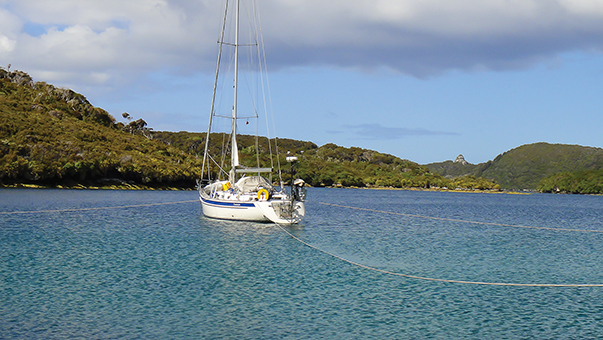Discovering rugged yet laid-back Stewart Island (published May 2013) photos by Jim Thomsen
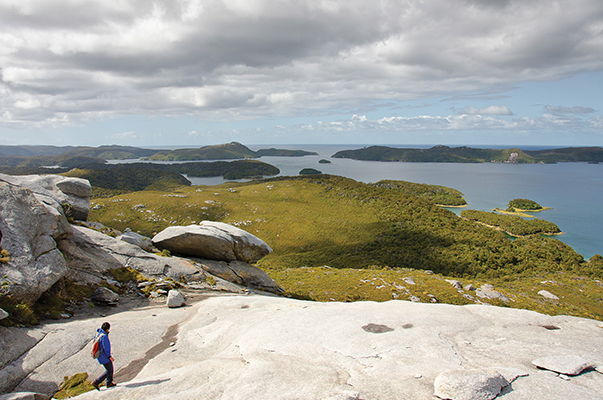
Most people believe New Zealand consists of just North and South Islands. But there is a third, further south, called Stewart Island. Straddling 47°S, it lies in the heart of the Roaring Forties. Westerly winds often blow at gale or storm force and blast the rocky western coast. The eastern coast is more protected and has two large, safe harbors, Paterson Inlet and Port Pegasus. Ferries from Bluff and small planes from Invercargill bring visitors to Oban, the island’s only town. Several well maintained tramping trails lead around and across the northern part of the island, but access to the southern part is by boat or float plane only. No roads or tracks lead to Port Pegasus and most of the 400 residents of Oban have never been down there.
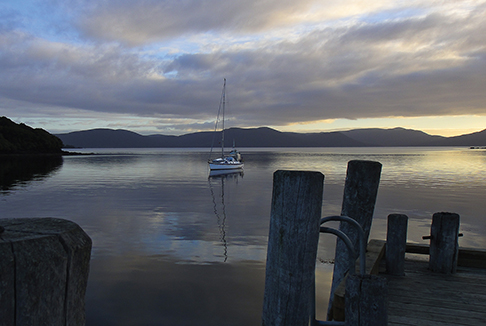
Many foreign yachts arrive in New Zealand each year to wait out the cyclone season, usually venturing no further south than Auckland. Traveling this beautiful country by land is a welcome break from months crossing the South Pacific in a rolling boat. Indeed, my husband Jim and I drove around South Island last year by campervan and took the ferry over to Stewart Island. We often found ourselves wondering what it would be like to sail in this very special place so we came back to New Zealand this year to do just that.
After nearly two months of exploring and enjoying Abel Tasman and Fiordland National parks on South Island on our yacht, Tenaya, it was time to move on. We began to watch for a weather window to cross the notorious Foveaux Strait. Two weeks later we got it. A high was building over the area allowing the strong winds and rough seas to ease long enough for us to make the 130-mile overnight passage from Dusky Sound to Port Pegasus.
Our route would take us southeast past the Solander Islands and the western side of Stewart Island, around South Cape (aka South West Cape) and up to Port Pegasus. South Cape is one of the five great southern capes, only Cape Horn is further south, which was somewhat angst provoking.
SOUTHBOUND
Up at dawn, we freed ourselves from the mooring outside Luncheon Cove and headed out to sea. We were sad to leave the magnificent and pristine wilderness of Fiordland, but were excited to explore the completely different, and even more remote, Stewart Island.
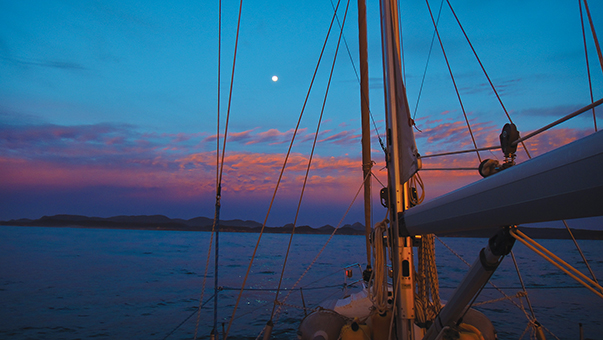
The sun was warm, winds were in the single digits and the seas were slight. The birdlife was plentiful with sooty Shearwaters gathering in numbers while prions and terns darted about. Mollymawks, small members of the albatross family, joined the larger Royal Albatross soaring effortlessly for miles.
The night was magical with a full moon and glassy sea. Clouds rolled by while the Southern Cross sparkled directly overhead. At one point during his watch Jim saw odd columns of light shooting skyward. He pondered for a moment before realizing they were the Southern Lights.
We were certainly surprised when the evening weather report said there was a storm warning for the area. Not a gale warning, a storm warning, that’s 55+ mph! Where did that come from? All we could do was ensure the boat was ready and wait nervously. We rounded South Cape on March 10—the same day that Captain Cook did 242 years earlier on his first voyage in the Endeavour—and slowed the engine down to arrive after dawn.
A swath of pink on the horizon intensified and turned the eastern sky a deep magenta and the western sky a brilliant deep blue before the sun rose. It is easy to understand why the Maori name for Stewart Island is Rakiura, meaning “Land of Glowing Lights”. As we entered the South Arm of Port Pegasus we passed a rare yellow-eyed penguin lazily fishing while a sea lion bull noisily followed us, perhaps chasing us from his territory.
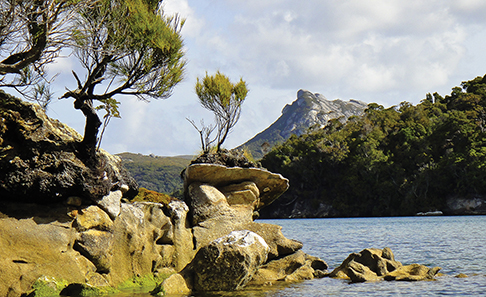
There are several “all-weather” anchorages in Port Pegasus and we headed for Evening Cove as the storm warning was still in effect. The guidebook says to drop the anchor in the middle of the cove and tie two stern lines to shore. It was low water when I paddled the windward line over to a strong tree with several lines tied around it. Instead of looping around the trunk, which was overhead and hard to reach, I ran our line through a loop in the beefiest line. Then I paddled the other stern line out and secured it around a tree. Once settled, we crawled into bed for a nap. We awoke to strong winds blowing from the southwest and found Harmony, a 26’ New Zealand yacht, anchored nearby.
We awoke several times during the night to check that all was okay. We hadn’t heard wind in the rigging for quite some time and it was a little disconcerting to have so much on the beam. In the morning Harmony moved further into the cove and we worried we might be stretching too close to the rocks but feared taking in any scope. As we sat in the cockpit pondering the situation, I noticed the line taking all the force go slack. Jim jumped up, started the engine and steered us into the middle of the cove. When I pulled the line in, the loop and bowline were still in place. The existing line had broken. Thank goodness it hadn’t happened during the night.
Needless to say, both stern lines were then tied around the thickest trees I could find. We added a third line off port amidships for good measure as that was directly into the wind. Tenaya looked like she was caught in a spider’s web, but she was secure.
Stewart Island is very different from any place we’ve ever seen. At first glance it seems open and mellow but on closer inspection the vegetation is often impenetrable. Rolling hills are dense with scrub brush, grasses, flax, tall rimu trees and piles of granite outcroppings scattered here and there. The whole island is rugged, windswept and isolated.
During the 18th to 20th century’s, adventurous pioneers of various nationalities arrived. Sealers, whalers, prospectors, shipbuilders, timbermen and flax harvesters settled here and married Maori women. Eventually these industries disappeared and the bush reclaimed most traces of their existence. What remains is an interesting mix of hearty people who have continued to survive in this harsh environment without many of the comforts of the mainland. Tourism, conservation work and fishing for cod, paua (abalone) and spiny lobster are the main interests today.
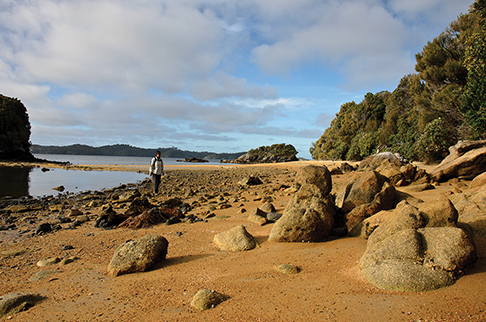
EXPLORING LAND AND SEA
When the weather cleared we were able to get out exploring and found a track that lead from the anchorage up to several granite domes. We hiked to the top of the closest highpoint. The track disappeared for a while and we made our way through the bush from boulder to boulder until we found it again, leading us to the top. From there we had a fabulous view of Port Pegasus.
There is a trail marked on our chart from a little cove at the southern end across to Boat Harbour in Broad Bay. We were told it is very pretty and there was once a settlement nearby. Hoping to hike over and see it, we motored a short distance, anchored and tied two lines to shore.
After the stern lines were securely ashore I paddled along the edge of the bay. It was low
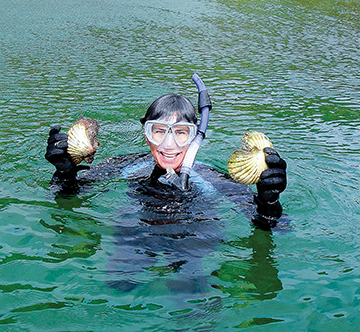
water and the rocks were a beautiful color in the brilliant sunshine. Swaying kelp alternately hid and revealed them. Suddenly I glimpsed a big paua in six inches of water. Excitedly, I reached down to pry it off the rock. No luck. I went back to the boat to get my proper paua prier and pulled on my wetsuit and gear. I had another incentive to get in the water as well. It was the last day of scallop season and we had yet to collect any ourselves.
“Katie, you have to actually put your wetsuit on and dive for your scallops,” were the email instructions from Billy in Deep Cove, Doubtful Sound. When I responded that it had been cold and windy and I was hesitant to get in the water he wrote, “Hi Katie, don’t be a bloody wussie, get in the water and paddle around looking down and you will see them.” Well okay then. I am not a wussie.
As we paddled along the shore looking for more paua a blue cod sprang out of the water and flopped about on a nearby rock. As Jim brought us alongside, I scooped the suicidal delicacy into the kayak. That’s the first time we’ve ever caught a fish without a line! Without a doubt, blue cod are our favorite tasting fish and they are only found in this region, nowhere else in the world.
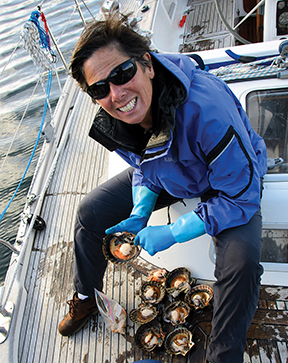
In the middle of the bay I peered over the side of the kayak but could not see any scallops. Billy’s words rang in my head so over the side I went. They were everywhere and I collected our limit of 20 in no time. As Jim paddled our dinner back to the boat I went for another try at the first paua, but it held firm. I found several more but they were so big I was unable to dislodge them and only succeeded in getting a small one.
Twice we went in search of the settlement in Broad Bay. Twice we were turned back by impenetrable bush. Whatever track had been there 20 years ago when the guidebook was written had long since vanished. Without any signs of habitation, we were keenly aware of our isolation and relished the solitude. The only other boats we saw in Port Pegasus were Harmony, who left before we did, two fishing boats and Southern Winds, the Department of Conservation boat with sea lion researchers aboard.
As a gale warning was in effect the day we moved to North Arm, we secured Tenaya in another “all-weather” anchorage with stern lines tied to shore. The wind howled through the treetops but very little stirred the water in protected Ben’s Bay. There is a tiny cove not far away that, if you were not searching for it, you would surely miss. A narrow opening between two rock walls is just wide enough for a dinghy to squeeze through. The tapered entrance widens into a secluded cove of emerald water with a sandy shore and bottom. Dark rocks are scattered about while ferns and other foliage dripping with moisture cling to the steep walls and form a canopy of green. It’s an enchanting little wonderland. Further up the arm, ruins can be found from an old fishing and freezing station as well as those from a tin mining operation.
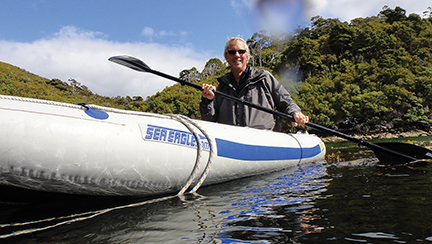
A SLICE OF CIVILIZATION
We awoke at dawn for the 50-mile trip from Port Pegasus north to Paterson Inlet. Our timing was right for the current that runs along the coast so we had a nice boost all the way. Wind speeds were 4 to 7 knots and the seas were moderate with the swell from two directions bouncing us around a bit. Clouds rolled in and out while the temperature remained chilly.
We anchored in Golden Bay as it is close to Oban with a wharf to leave the kayak. It is a pretty and quiet setting. And without having to deal with stern lines, it was finally simple to just drop the hook, attach the snubber, back down and be done with it. After so many weeks in remote anchorages, it was nice to visit a town with a grocery store and a restaurant with Wi-Fi. We met several locals who invited us to their homes. One couple made us dinner and another offered us the use of his mooring at Ulva Island, a bird sanctuary.
Before we were ready to leave this amazing island, we received word from Commander’s Weather that a weather window was opening for us to sail to Dunedin on South Island’s eastern side. So off we went. It was a fabulous overnight sail with winds 20 to 30 knots from behind and following seas: a perfect way to leave such a wonderful place.
Katie Thomsen was living in Antwerp, Belgium when she returned from a liveaboard kayaking trip in the scenic waters off Vancouver Island, BC and announced, “I could live on a boat.” Being a diehard mountain person , this was big, but, two years later that’s precisely what she was doing. It took a full season and 50 hours of private lessons before she felt comfortable handling Tenaya, their new 2006 40 foot Hallberg Rassy sloop, in the protected waters of Zeeland, the Netherlands. Then she and husband, Jim, sailed out into the North Sea, down the Atlantic coast and into the Mediterranean. Having mastered ‘coastal cruising,’ she yearned for an ocean passage and convinced Jim to cross the Atlantic. After sailing up and down the Eastern Caribbean they crossed through Panama and into the Pacific. Each mile sailed increased her confidence and skill, and each island explored opened her eyes and heart to the world around her. Now six years and 30,000 miles later, Katie continues her quest to improve her sailing skills by venturing into higher latitudes while delving deeply into the lands and cultures she finds herself immersed.

















